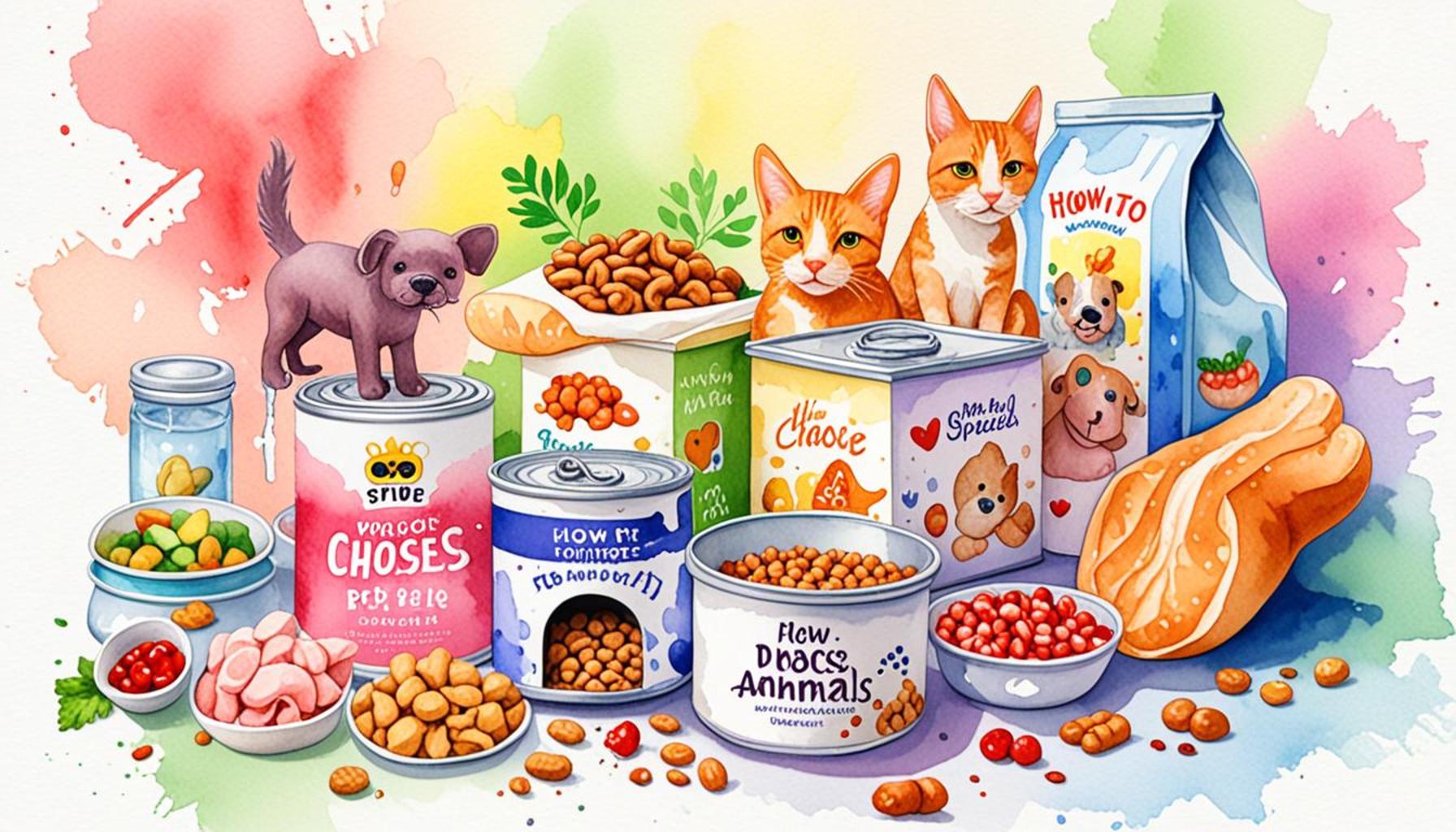How to Read and Understand Pet Food Labels

The Importance of Understanding Pet Food Labels
For many pet owners, the quest to provide a nutritious diet for their beloved animals begins at the pet food aisle. Yet, understanding how to read pet food labels can be a daunting task, akin to navigating a labyrinth of terms and regulatory jargon. However, investing your time in grasping what these labels convey is essential to ensuring that your four-legged companions receive the nutrients they need to thrive.
Pet food labels are packed with vital information that requires careful attention. One critical component is the ingredients list, which reveals not only the primary constituents of the food but also highlights the quality of those ingredients. Typically, ingredients are listed in descending order by weight, meaning that the first ingredient is the most significant by quantity. For instance, a label that lists whole chicken as the first ingredient suggests a higher quality protein source compared to one that lists meat by-products.
Equally important is the nutritional adequacy statement, which informs you whether the food complies with established nutritional standards set by regulatory bodies, such as the Association of American Feed Control Officials (AAFCO). This statement usually indicates if the diet is formulated for a specific life stage—like growth for puppies or maintenance for adult dogs—ensuring you choose a feed suitable for your pet’s needs.
The guaranteed analysis section breaks down the nutritional profile of the food, specifying the minimum levels of certain nutrients such as protein and fat, and the maximum levels of fiber and moisture. Understanding this breakdown helps pet owners gauge whether the diet meets their pet’s dietary requirements. For example, a dog that requires a high-protein diet might need a food that has at least 30% protein content.
Moreover, the feeding guidelines provided on the packaging direct pet owners on the appropriate portion sizes to ensure their pets are getting the right amount of food without overfeeding. It’s essential to consider not only your pet’s weight but also their age, activity level, and health condition when following these guidelines.
Additionally, terms like “natural,” “organic,” or “grain-free” may entice consumers but can often be misleading. It’s crucial to research these claims and understand their definitions according to AAFCO regulations, as not all labels mean the same thing across different brands.
In summary, pet food labels are more than just marketing tools; they are essential resources that can greatly impact your pet’s health and well-being. By equipping yourself with the knowledge needed to interpret these labels, you can choose a diet that supports your pet’s specific needs and lifestyle. This understanding will empower you, ensuring your furry friend enjoys a long and healthy life.
Decoding the Ingredients List
One of the most crucial sections of a pet food label is the ingredients list. The first step in understanding what your pet is consuming lies within these seemingly simple words. Ingredients are typically presented in descending order by weight, which means that the highest weighted ingredient appears first. This hierarchy can significantly affect the nutritional quality of the diet you choose for your furry companion.
When you glance at the ingredients list, look for identifiable sources of protein, as dogs and cats thrive on proper amino acids. You may come across ingredients such as chicken, beef, or salmon. These whole protein sources are preferable to vague terms like meat meal or meat by-products, which can include unspecified parts of the animal and may vary in nutritional value.
It’s essential to be aware that certain ingredients—such as corn, wheat, or soy—are often included as fillers to meet protein requirements but may not provide significant nutritional benefits for your pet. High-quality brands will usually emphasize whole grains or no grains at all, depending on the dietary needs of your pet.
Understanding Nutritional Adequacy Statements
Another pivotal component of pet food labels is the nutritional adequacy statement. This statement tells you whether the food meets the standards set forth by the Association of American Feed Control Officials (AAFCO). When scrutinizing this section, you may notice phrases like “complete and balanced,” which indicates that the food provides all the essential nutrients required for a specific life stage (e.g., growth, maintenance).
Pet owners should also watch for the life stage statement that corresponds to their pet’s needs. Nutritional requirements differ significantly between puppies and adult dogs, or kittens and adult cats, so verifying this detail on the package can prevent dietary missteps.
Examining the Guaranteed Analysis
The guaranteed analysis section further empowers pet owners by breaking down the nutritional profile of the food. Here, you’ll find the minimum percentages of key nutrients: protein, fat, fiber, and moisture content. Understanding these percentages can help you determine if a specific pet food aligns with your pet’s dietary requirements. For example:
- A high-energy dog may require a minimum of 30% protein to support muscle maintenance and activity levels.
- Pets with certain health conditions might need diets lower in fat or fiber; thus, finding the right balance is essential.
Also, keep in mind that these guaranteed analyses should not be interpreted in isolation. They are just an indication of the nutritional profile, and the actual quality can vary widely based on the source and digestibility of the ingredients used. This is why comparing different brands can reveal insightful variances in optimal nutrition for your pet.
With a deeper understanding of the ingredients list, nutritional adequacy, and guaranteed analysis, you can take meaningful steps toward making informed choices that support the health and well-being of your pet. Armed with this knowledge, you’ll be well-equipped to navigate the sometimes overwhelming world of pet food labels and ultimately find the best diet suited to your furry friend.
Understanding Ingredients: The Foundation of Pet Food Labels
When diving into the world of pet food labels, one of the most crucial elements to comprehend is the ingredient list. Ingredients are generally listed in order of their weight, which means the first few ingredients are the most significant. This knowledge can dramatically impact your choices when selecting the right food for your pet. High-quality protein sources should be among the top ingredients. Look for specific meats, such as chicken, beef, or fish, rather than generalized terms like “meat by-product.” This specificity ensures that your pet is getting nutrient-rich components that foster healthy growth and energy levels.
Decoding Nutritional Information
The nutritional adequacy statement is another key area of focus on the label. This statement reassures pet owners that the food meets the established nutritional levels set by the Association of American Feed Control Officials (AAFCO). Understanding this statement helps you to ensure that the selected pet food is complete and balanced per established standards. Additionally, understanding terms like “grain-free” or “limited ingredient” can help you cater to your pet’s dietary needs. While grain-free diets are popular for pets with allergies or sensitivities, not all pets require this type of diet. Consulting with a veterinarian about your pet’s specific nutritional needs is always a wise move.
| Ingredient Quality | Nutritional Standards |
|---|---|
| Specific & Whole Ingredients | Meets AAFCO Standards |
| High-quality Proteins | Complete & Balanced Nutrition |
Understanding these components of pet food labels not only empowers you as a pet owner but also ensures that your furry companions receive the nourishment they need for a healthy life. Stay informed and curious to ensure you’re making the most educated decisions regarding your pet’s diet.
Deciphering Additives and By-products
As you continue to analyze pet food labels, it becomes essential to familiarize yourself with additives and by-products. These components can significantly influence your choice and understanding of the overall quality of the pet food your animal consumes. Additives may include vitamins, minerals, and preservatives which are often crucial for maintaining the nutritional integrity of the food. Look for identifiable and natural sources, as these typically point to a higher-quality product.
On the other hand, by-products can be a controversial topic among pet owners. By-products are parts of the animal that aren’t considered pure meat, such as organs, bones, or skin, which may be beneficial in certain contexts. While by-products can provide valuable nutrients and usually help keep costs low, their inclusion demands scrutiny. Always consider whether the source of the by-products is named, like “chicken by-products”, which is more acceptable than just “meat by-products”.
Recognizing Artificial Ingredients
When it comes to pet food, a fundamental aspect of making an educated decision involves identifying the presence of artificial ingredients. These include artificial flavors, colors, and preservatives like BHA, BHT, and ethoxyquin. Although they are often used to enhance the appeal or shelf-life of the product, their long-term effects on pet health are debated among experts. Opting for brands that utilize natural preservatives such as mixed tocopherols or vitamin E can be a wiser choice in safeguarding your pet’s health.
Moreover, it’s interesting to note that the pet food industry has witnessed a push toward transparency and higher standards in recent years. With consumers increasingly demanding wholesome ingredients, many manufacturers are reformulating their products to eliminate artificial ingredients and embrace natural alternatives.
The Role of Marketing Terms
Reflect on the marketing terms often found on pet food labels, as these can sometimes mislead consumers. Phrases like “natural,” “premium,” or “holistic” may sound appealing but lack regulatory definition. For example, a food labeled as “natural” could still contain non-prescribed additives that don’t align with what many pet owners envision for their furry friends. Understanding that not all marketing language bears equal weight is vital in discerning the authenticity of what’s in the bag.
Additionally, terms like “grain-free” might be misleading unless confirmed with scientific evidence or a solid nutritional approach tailored to your pet’s health needs. Some pets may thrive on grains depending on their individual dietary needs, so it’s crucial to avoid blanket statements when assessing effectiveness.
Consulting Your Vet for Personalized Advice
Ultimately, it’s best to consult your veterinarian when selecting the right pet food, especially if your animal has unique health requirements or gleaning from the myriad of choices in commercial pet food. A vet can provide personalized guidance based on your pet’s age, breed, and health conditions. Collaborative discussions can help you sift through pet food labels, enabling more choices that align with your pet’s specific needs and lifestyle.
With a solid understanding of additives, by-products, artificial ingredients, marketing terms, and veterinary input, you’ll be better equipped to make confident decisions when selecting the ideal diet for your pet. Remember, a little knowledge can lead to significant improvements in the health and happiness of your furry companions.
Conclusion
Deciphering pet food labels is not only a valuable skill but also a necessary one for ensuring the health and well-being of our beloved companions. As we’ve explored, understanding the ingredients, nutritional content, and potential additives on the labels can significantly impact your pet’s diet and overall quality of life. By looking for whole food sources, identifying harmful artificial ingredients, and knowing how to interpret marketing jargon, you empower yourself to make informed decisions.
Additionally, never underestimate the importance of consulting your veterinarian. Their expertise can guide you through the myriad of options and help tailor your pet’s diet to their individual needs, whether they require a specific formulation due to age, breed, or health challenges. In an era where the pet food market is continually evolving, awareness and education are paramount.
Ultimately, your commitment to understanding what goes into your pet’s food can lead to healthier choices and a happier life for your furry friends. Armed with knowledge, you can confidently navigate the aisles of pet food options and ensure that every meal contributes positively to your pet’s health. So, the next time you’re shopping for pet food, remember: knowledge is power, and your choice matters. Take the time to read and understand those labels—your pet deserves nothing less.


